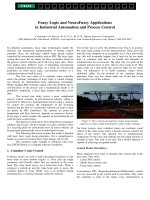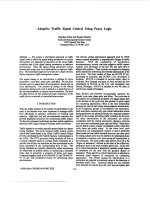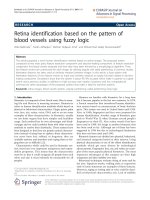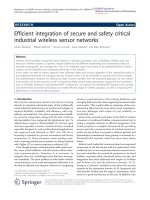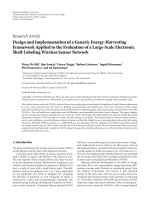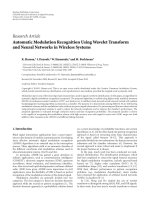Using fuzzy logic and search algorithms to balance consumption power and maximum lifespan for wireless sensor network
Bạn đang xem bản rút gọn của tài liệu. Xem và tải ngay bản đầy đủ của tài liệu tại đây (1.16 MB, 6 trang )
Phan Thi The, Nguyen Quoc Thinh, Nguyen Thanh Tuan, Tran Cong Hung
USING FUZZY LOGIC AND SEARCH
ALGORITHMS TO BALANCE CONSUMPTION
POWER AND MAXIMUM LIFESPAN FOR
WIRELESS SENSOR NETWORK
Phan Thi The*, Nguyen Quoc Thinh# , Nguyen Thanh Tuan#, Tran Cong Hung#
* Department of Information Technology, Thu Duc College, Ho Chi Minh, Viet Nam
#
Department of Information Technology, Posts and Telecommunications Institute of Technology
Ho Chi Minh, Viet Nam
Abstract: The most important issue for designing wireless sensor
network routing protocols is energy efficiency. Our study uses a
combination of both fuzzy logic and A-star algorithms that improve
priority level in selecting node to form route. This algorithm is
capable of selecting the best routing from the source node to the base
station by prioritizing the highest remaining power, minimize number
of hop, lowest traffic load. The performance of the proposed
algorithm is evaluated and compared to the other three methods
according to the same criterion. Simulation results show the
effectiveness of the new approach for enhancing wireless sensor
network lifetime with scattered random nodes
nodes can not be reloaded or replaced. After the power is
exhausted, nodes turn dead and stop working. Because the
network can not perform the assigned tasks after the node dies.
Longevity wireless sensor networks are an important parameter
when evaluating the performance of routing protocols [1].
Keywords: Wireless Sensor Network, energy efficiency, A-star
algorithm, fuzzy logic, network lifespan.
Our paper study on routing protocols and applications of
fuzzy logic in wireless sensor networks. In this study, we first
propose a fuzzy approach in conjunction with the A-Way path
search algorithm in the route selection process for WSNs. It
enables optimal data transfer from source to destination by
considering three routing criteria: maximum residual energy,
minimum number of hop and lowest traffic load. Next, the new
approach introduces a priority variable in the selection of good
sensor nodes (low power consumption at low transmissions)
compared to randomly selecting algorithms for nodes and
distributing data from the sensor node to the base station (BS)
as fast as possible and save the most energy. To evaluate the
effectiveness of our proposal, we analyzed simulation results
comparing our approach with the fuzzy approach and the A-star
algorithm using the same routing standard for data transmission
costs. , average power consumption and life cycle of the
network using the matlab network simulation. Simulation
results demonstrate that network life is significantly increased
when using the proposed routing method.
I. INTRODUCTION
The Wireless Sensor Network can accommodate up to
thousands of sensor nodes using wireless links (radio, infrared,
or optical) to coordinate the data acquisition task with large
scale dispersion in any geographical area, monitoring
temperature, sound, vibration, pressure, motion or
contaminants. The sensor node processes, stores and sends
information collected to other nodes in the network, to the main
location or transceiver where the data is being reviewed and
analyzed. Due to the limitations of memory nodes, power and
computing power, to transmit data the sensor nodes require a
power source; if a node is insufficient power, it can not
transmit data, In addition, irregular power dissipation can
significantly reduce network lifetime
Unbalanced power consumption is a inherent problem in
wireless sensor networks which characterized by multi-hop
routing and multiple source traffic flows to one destination.
And uneven energy consumption can significantly reduce
network life. In general, in the routing algorithm, the best path
is chosen to transfer data from source to destination. For a
period of time if the same path is selected for all interfaces to
achieve battery performance in terms of fast transmission time,
the nodes on this route will suffer a rapid energy consumption
[1], [ 2], [3]. In most applications of wireless sensor networks,
sensor nodes are deployed in large-scale areas. When deploying
In traditional optimal path routing schemes in wireless
sensor networks, each node selects specific nodes to move data
according to a number of criteria to maximize network life.
Due to this concept, the problem of wireless sensor life is
always noticeable.
The structure of this article is composed of four parts: Part
1, Part 2 presents The Related Work, Part 3 Proposed
Algorithms, Part 4 Simulation and Evaluation, and the final
part is the conclusion.
II. RELATED WORKS
To provide proposal algorithm, We have studied some of
the following related works:
Corresponding Author: Phan Thi The
Email:
Manuscript received: 10/2018, revised: 12/2018, accepted: 12/2018.
SỐ 4 (CS.01) 2018
TẠP CHÍ KHOA HỌC CÔNG NGHỆ THÔNG TIN VÀ TRUYỀN THÔNG
16
USING FUZZY LOGIC AND SEARCH ALGORITHMS TO BALANCE CONSUMPTION POWER …
Yali Yuan and colleagues in the study "CAF: Clustering
Algorithm and A-Star with Fuzzy Approach" [4] proposed a
new routing method in the network Wireless sensors for
extending network life use a combination of a clustering
algorithm, a fuzzy approach, and an A-star method.
Vuyyuru. Lalitha. V et al. [5] proposed a new routing
method for wireless sensor networks for the use of minimal
energy using a combination of fuzzy logic and the A-star
algorithm with the Leach protocol. The proposed method for
high throughput, reduced packet loss rate and minimal power
consumption of sensor nodes.
Chandra Prakash Yadav and others [6] in the paper "An
Efficient Routing Method for Lifetime Enhancement in a
Wireless Sensor Network", also proposed a combination of
fuzzy logic and the A-star algorithm How to choose the optimal
route from source to destination based on the highest remaining
battery power, minimum hop number, and lowest traffic load.
Haifeng Jiang et al. [7] based on the energy consumption
analysis for data transceivers, single-hop forwarding
mechanisms have been shown to consume more energy than
multi-hop transmissions within the transmission range Source
sensor or transceiver current. The authors predicted the residual
energy of the neighboring node after selecting the next node.
Based on the energy imbalance, the method is designed to
calculate the energy balance. Parameters such as the proximity
of the node to the shortest path, the proximity of the node to the
transceiver and the level of energy balance are fed into the
fuzzy logic system. The optimized routing algorithm is based
on the fuzzy logic proposed to achieve multiple parameters,
deciding the fuzzy routing.
Author Tran Cong Hung and Phan Thi The [8] (2015) study
to select clusters (CH) and use the Dijkstra algorithm to find
the shortest path to the clusters and base stations (BS) This
algorithm presents the shortest path between cluster and
adjacent node, ensuring that this algorithm provides low cost
power transmission and consumption. To optimize power
consumption and maximize the WSNs network life span, the
deployment of sensor balances as well as low path costs is
found by Dijkstra's algorithm. Dijkstra's algorithm will find the
lowest cost route based on the route distance, while the authors
propose to apply the energy model to Dijkstra's algorithm to
select the optimal route to the host cluster. Therefore, that is the
reason for equal energy consumption. In this study, the author
studied cluster cluster classification and used Dijkstra's
algorithm to reduce energy consumption.
A.Set up Fuzzy logic
Fuzzy logic refers to analyzing information using fuzzy
sets, each of which can represent a linguistic term such as
"Low", "High" ... Fuzzy sets are described by the actual
range of values. the mapped set, called domain, and
membership function. A membership function assigns an
authentication value between 0 and 1 to each point in the
domain of the fuzzy set. Depending on the shape of the jaw
function, different types of fuzzy sets can be used such as
triangles, beta, PI, curves, sigma ...
Fuzzy values are handled by deductive mechanisms,
including a rule base and various methods to deduce rules.
The simple rule base is a series of If-Then rules involving
input fuzzy variables with output fuzzy variables using
linguistic variables, each of which is described by a fuzzy
set and the fuzzy operation "And", "Or". All rules in the
rule base are handled in a parallel method by inference
structure.
The objective of the fuzzy program of the proposed
protocol is to determine the optimal cost value for a link
between two sensor nodes so that the network life is
maximized. The lifespan of wireless sensor networks is
usually defined as the time when the power level of the first
sensor node becomes zero. The fuzzy rule base has been
adjusted to not only prolong the life of the sensing network.
but also to efficiently balance the load between the sensor
nodes so that the maximum number of nodes has enough
power to continue performing their own sensor tasks.
A number of different indicators are used to extend the life
of sensor networks. These indicators are as follows [6]:
Remaining Energy (RE), Minimum Hop (MH), Traffic
Load (TL).
The proposal protocol determines the optimal value of NC
(n) of node n depending on the remaining energy RE (n)
and load TL (n), using the five associated functions for
each of the nodes. (RE, TL) and an output variable (NC) as
shown in Figures 1, 2, 3, 4.
III. PROPOSED ALGORITHM
The main goal is to design an algorithm to extend the life of
wireless sensor networks by limiting energy costs as well as
distributing energy consumption evenly. Our proposal
introduces a new approach by combining a fuzzy and AStar algorithm to select the optimal routing route from
source to destination by considering three routing criteria
(Power combined with variable α (normal node and good
node) to select the optimal node relative to the algorithm to
randomly select nodes and balance them to extend the life
of the sensor network. The process consists of two parts:
SỐ 4 (CS.01) 2018
Figure 1: Fuzzy logic with 2 input variables (RE, TL) and NC output
variable
TẠP CHÍ KHOA HỌC CÔNG NGHỆ THÔNG TIN VÀ TRUYỀN THÔNG
17
Phan Thi The, Nguyen Quoc Thinh, Nguyen Thanh Tuan, Tran Cong Hung
m
high
high
Low
Very Low
Mediu
m
Mediu
m
High
Very
high
Medium
Very Low
Low
Mediu
m
High
Very
high
High
Very Low
Low
Low
Very high
Very Low
Very
Low
Low
Mediu
m
Mediu
m
High
High
Finally, the defuzzy will find a unique output value from
the fuzzy solution. This value represents the cost of the
node. Defuzzy is calculated by the below formular
Figure 2: Linked graph for input variable Energy remaining (RE)
Node_Cost=
(1)
Where Ui is the output of the rule base i, Ci is the center
output of the function
B. Set up A-Star algorithm
Energy Consumption Models: The energy consumption of
each sensor node consists of three components: sensor
energy, transmission energy, and data processing power.
Sensors and data processing require less power than
transmitting. This proposal uses the same energy
consumption model as Heinzelman used for wireless
transmission hardware [9], [10], [11].
Figure 3: Link graph for input variables Load (TL)
In the new approach, the base station prepares the routing
schedule and broadcasts it to each node. The A-Star
algorithm finds the optimal route from the node to the base
station and applies to each node. The A-star algorithm
creates a tree structure to find the optimal route from a
given node to the base station, the tree node is found based
on the algorithm's evaluation function as follows:
f(n) = [NC(n) + (1/MH(n))] * α (2)
If f (n) is large, then the optimal node is chosen.
Where:
Figure 4: Link graph for output variable Cost node (NC)
For the fuzzy approach, fuzzy values are handled by the
inference mechanism, including a rule base and various
methods for inferring the rules. Table 1 shows the if-then
rules used in the proposed method for a total of 52 = 25
basis fuzzy rules. For example, if RE (n) is very high and
TL (n) is very low then NC (n) is very high. All of these
rules are treated in parallel with a fuzzy reasoning
mechanism.
Table 1: If-Then Rules
RE(n)
TL(n)
Very Low
Very Low
Low
Mediu
m
High
Low
Mediu
High
Very
SỐ 4 (CS.01) 2018
Very
high
-
NC (n) is the cost of node n, which has values [0 ... 1]
and is computed by fuzzy logic. This value is
calculated based on the remaining energy of node n (n)
and the traffic load of n nodes (n).
-
MH (n) shortest distance from node n to base station.
-
Variable α: α = 1.5 if node is good and α = 1 if node is
normal. Here we set a small percentage of good nodes
to conduct experiments compared with the
experimental results of the authors in [11] (authors use
different energy levels between good and normal node,
same level energy consumption for nodes), [12]
(authors use the same energy level, the same power
Very
TẠP CHÍ KHOA HỌC CÔNG NGHỆ THÔNG TIN VÀ TRUYỀN THÔNG
18
USING FUZZY LOGIC AND SEARCH ALGORITHMS TO BALANCE CONSUMPTION POWER …
consumption for nodes and randomly selected under
the initial conditions) for comparison.
The proposed method will preferentially select the best
node on the routing route instead of randomly selecting the
neighboring node in function f (n) without priority
weighting. Choosing this good node helps to get the idea
that when designing a wireless sensor network, it inserts
some sensor nodes with lower power consumption than
normal nodes, thus improving the algorithm. In this case, it
is recommended that in the case of good node selection
algorithms, this will help in some cases (except in special
cases). The amount of transmission and increase the life
cycle.
Figure 5 depicts the flowchart of the proposed algorithm
combining fuzzy logic and A-star algorithm in optimal
routing (with priority consideration) to increase wireless
sensor network life.
IV.
SIMULATION AND EVALUATION OF RESULTS
A. Detailed hypothesis and initial setup for the simulation
process:
The nodes in the network know the topology of the
network. Know your location, proximity node location, and
base station. The same transmission distance and two types
(normal node and good node). All nodes in the network can
transmit data directly to the base station (Sink).
Number of nodes in network N = 100 nodes (20 good nodes
have power dissipation during transmission, lower than normal
nodes). Network simulation range (100m x 100m). The base
station is located at (0, 50). The transmission distance limit is
30m. The initial energy of all buttons iEnergy = 0.5J.
Energy consumes a bit: Eelec = 50nJ / bit (regular node),
Eelec = 10nJ / bit (good node). Amplifier: Eamp = 100pJ / bit /
m2 (regular node), Eamp = 20pJ / bit / m2 (good node).
The length of each packet k = 2000 bits. Packet numbers:
5000, 10000, 15000, 20000.
The maximum number of flows in a node's queue is 10.
Our simulation is installed on MATLAB R2017a. The
nodes in the network are allocated randomly. The simulation
process consists of the following steps:
Step 1: Find the neighbor node.
Step 2: Set up the optimal route.
Step 3: Transfer data to base station.
B. Simulation:
Figure 5: Flow chart of Proposal Algorithm
Figure 6: Average remaining energy after 20,000 rounds
In wireless sensor networks, the node are limited by battery
power, so the use of energy efficiency is very important.
Another feature is that the lifespan of the network is related
to route selection. Unbalance energy is a problem in the
WSN network. Thus, the new proposal approach is to chose
the optimal route from the source node to the point of
acquisition based on the remaining energy, minimum hop,
lowest traffic load using a combination of fuzzy approach
and A-star algorithm to increase the lifespan of wireless
sensor networks.
SỐ 4 (CS.01) 2018
TẠP CHÍ KHOA HỌC CÔNG NGHỆ THÔNG TIN VÀ TRUYỀN THÔNG
19
Phan Thi The, Nguyen Quoc Thinh, Nguyen Thanh Tuan, Tran Cong Hung
when running simulated conditions, in the fourth round with
the number of rounds reaching 20000 energy averages the rest
was 0.35 higher than 0.25, the number of live nodes was 93
higher than 79 of the A-star & Fuzzy method [12]. Thus, this
algorithm has the ability to select the optimal routing route
from the source node to the base station by prioritizing the
highest remaining power, minimum number of hop, lowest
traffic load, and good node. The performance of the proposed
method was evaluated and compared to the other three methods
according to the same criteria. Simulation results show the
effectiveness of the new approach in prolonging wireless
sensor lifespan with scattered random nodes.
For future research, improvements may include the
following: make improvements on other routing protocols,
apply for heterogeneous sensor networks, We will use fuzzy
logic combine with some other mobile sink algorithms.
REFERENCES
Figure 7: Number of live nodes after 20000 rounds
K. Akkaya, M. Younis, (May 2005), “A survey on routing protocols for
wireless sensor networks”, Ad Hoc Networks, vol3 (no 3), pp325-349.
[2] Sharma and S K Jena (February 2011), A Survey on Secure Hierarchical
Routing Protocols in Wireless Sensor Networks, ICCCS’11.
[3] H. Zhang, H. Shen (Oct 2009), “Balancing Energy Consumption to
Maximize Network Lifetime in Data-Gathering Sensor Network”, IEEE
Trans Parallel Distrib Syst, vol20 (no 10), pp 1526-1539.
[4] Yali Yuan, Caihong Li, Yi Yang, Xiangliang Zhang, and Lian Li (28
April 2014), “CAF: Cluster Algorithm and A-Star with Fuzzy Approach
for Lifetime Enhancement in Wireless Sensor Networks”, Hindawi
Publishing Corporation Abstract and Applied Analysis, Vol2014
(ArticleID 936376).
[5] Vuyyuru. Lalitha, V. Vittal Reddy (2017), “A Novel Approach for
Minimizing Energy Utilization and Maximizing Network Lifetime for
Mobile Wireless Sensor Networks”, International Journal of Engineering
Development and Research, vol5 (issue 3), pp 2321-9939.
[6] Chandra Prakash Yadav, Reena Kumari jain, Sunil Kumar Yadav
(March 2014), “An Efficient Routing Method for Lifetime Enhancement
in Wireless Sensor Network using Fuzzy Approach and A-Star
Algorithm”, International Journal of Engineering and Innovative
Technology, vol3 (issue 9), pp 2277-3754.
[7] Haifeng Jiang, Yanjing Sun, Renke Sun, and Hongli Xu (11 July 2013),
“Fuzzy-Logic-Based Energy Optimized Routing for Wireless Sensor
Networks”, Hindawi Publishing Corporation International Journal of
Distributed Sensor Networks, vol2013 (Article ID 216561).
[8] Tran Cong Hung, Phan Thi The (2015), “A Proposal to Reduce Energy
Consumption for Wireless Sensor Network”, Cyber Journals:
Multidisciplinary Journals in Science and Technology, Journal of
Selected Areas in Telecommunications (JSAT), vol5 (no 7).
[9] X. H. Li, S. H. Hong, K. L. Fang (Sep 2011), “WSNHA-GAHR: a
greedy and A* heuristic routing algorithm for wireless sensor networks
in home automation”, IET Commun, vol5 (no 13), pp 1797-1805.
[10] Heinzelman R. (2000), “Energy Scalable Algorithms and Protocols for
Wireless Sensor Networks”, in Proceedings of the International
Conference on Acoustics, Speech, and Signal Processing (ICASSP’00),
Turkey, pp. 773-776.
[11] W. R. Heinzelman (2000), Application-Specific Protocol Architectures
for Wireless Networks, Massachusetts Institute of Technology,
Cambridge, Mass, USA.
[12] Imad S Alshawi, Lianshan Yan, Wei Pan. Bin Luo (October 2012),
“Lifetime Enhancement in wireless sensor network using fuzzy approach
and a-star algorithm”, IEEE Sensors journal, vol12.
[1]
Figure 8: Statistics of rounds when first node and fifty node died (4th
time)
The result of Figure 6 shows that the remaining energy of
the proposed method is lower than the A-star but higher than
the other two modes. After 20000 rounds, the number of
surviving nodes of the proposed method is 93 times lower than
the A-star & Fuzzy with 99 nodes, higher than the A-star, the
opaque approach is 92, 87 nodes, as shown in Figure 8. The
new method has the first node dies at 12196 while the A-star is
1153, A-sao & Fuzzy is 11537, the fuzzy approach is 15088.
The results show that the efficiency of the proposed method in
balancing power consumption and maximizing network life.
V.
CONCLUSION
The proposed algorithm uses a combination of both fuzzy
approaches and the A-star algorithm to improve the priority in
selecting the route-forming node. Evaluation results show that
the proposed method outperforms the proposed protocols [12]
SỐ 4 (CS.01) 2018
TẠP CHÍ KHOA HỌC CÔNG NGHỆ THÔNG TIN VÀ TRUYỀN THÔNG
20
USING FUZZY LOGIC AND SEARCH ALGORITHMS TO BALANCE CONSUMPTION POWER …
Tóm tắt: Vấn đề quan trọng nhất để thiết kế các giao thức
định tuyến mạng cảm biến là hiệu quả năng lượng. Nghiên
cứu của chúng tôi sử dụng kết hợp cả hai phương pháp tiếp
cận mờ và thuật toán A-sao có cải tiến độ ưu tiên trong việc
lựa chọn nút hình thành tuyến đường. Thuật toán này có khả
năng chọn tuyến đường định tuyến tối ưu từ nút nguồn đến
trạm gốc bằng cách ưu tiên năng lượng còn lại cao nhất, số
bước nhảy tối thiểu, tải lưu lượng thấp nhất và là nút tốt. Hiệu
suất của thuật toán đề xuất được đánh giá và so sánh với ba
phương pháp khác theo cùng tiêu chí. Kết quả mô phỏng cho
thấy hiệu quả của phương thức tiếp cận mới trong việc tăng
cường tuổi thọ mạng cảm biến không dây với các nút ngẫu
nhiên phân tán.
Từ khoá: mạng cảm biến, hiệu quả năng lượng, thuật toán
A-sao, logic mờ, tuổi thọ mạng, định tuyến.
Phan Thi The was born in Vietnam in
1982.She
received
Master
Data
Transmission
and
NetWork
in
HOCHIMINH PTIT, Vietnam, 2012. She is
currently a PhD.Candidate in Information
System from Post & Telecommunications
Institute of Technology, Vietnam in
2019.She is working as a lecture in Thu Duc
College
Nguyen Thanh Tuan was born in
Vietnam in 1989. He received the Master of
Management information system from Post
&
Telecommunications
Institute
of
Technology, Vietnam, 2016. He is,
currently, a PhD.Candidate in Information
System from Post & Telecommunications
Institute of Technology, Vietnam in 2020.
He is working as a Teacher at Nha Trang
Tourism College, Khanh Hoa, Vietnam.
Tran Cong Hung was born in Vietnam
in 1961. He received the B.E in electronic
and Telecommunication engineering with
first class honors from HOCHIMINH
University of technology in Vietnam, 1987.
He received the B.E in informatics and
computer engineering from HOCHIMINH
University of technology in Vietnam, 1995.
He received the master of engineering
degree in telecommunications engineering
course from postgraduate department Hanoi
University of technology in Vietnam, 1998.
He received Ph.D at Hanoi University of
technology in Vietnam, 2004. His main
research areas are B – ISDN performance
parameters and measuring methods, QoS in
high speed networks, MPLS. He is,
currently, Associate Professor PhD. of
Faculty of Information Technology II, Posts
and Telecoms Institute of Technology in
HOCHIMINH, Vietnam.
Nguyen Quoc Thinh was born in Vietnam
in 1989. He received Master in Post &
Telecommunications
Institute
of
Technology, Vietnam in 2019. He is
working as a engineer in FPT Software Ho
Chi Minh.
SỐ 4 (CS.01) 2018
TẠP CHÍ KHOA HỌC CÔNG NGHỆ THÔNG TIN VÀ TRUYỀN THÔNG
21
